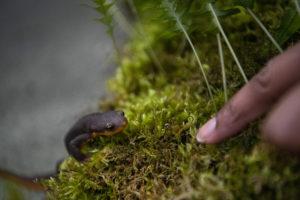No, they don’t belong in a witches’ brew. Nor are they conclusive proof of nearby magic. But they do have superpowers of killing and healing, plus the ability to charm humans at a single, big-eyed glance. For a creature just four inches long, rough-skinned newts have a lot of personality – and Ricotta and Gnocchi are no exception.

Recently arrived at the Cheney Discovery Center (currently closed due to Covid-19 restrictions), the two little newts aren’t related, though they live in the same fern-filled habitat and occasionally climb over each other. They also like interacting with humans, drinking in the scene with big round eyes and investigating keepers’ fingers. (The newts are moved several times a week to eat their dinner in separate containers, to make sure everybody gets their fair share.)
“They get along really well,” says keeper Miranda Mauck, as Ricotta clambers through the ferns like a tiny dinosaur with Gnocchi following, nose to tail.
“They’re pretty visual animals, so they’re very interested in anything new to see,” adds keeper Wendi Mello. “They’re total crowd-pleasers.”
Interestingly, their biological sex is unknown – it’s hard to tell with newts until they come into breeding season, Mauck says. So right now, Ricotta and Gnocchi are using they/them pronouns. At 17 grams, Ricotta is just a tiny bit bigger than Gnocchi, with a wide, ribbony tail and lighter skin.

Rough-skinned newts are a type of salamander found up and down the west coast of the U.S. and British Columbia. Eating worms, insects and other invertebrates, they live in moist forests, lakes, ponds and wetlands, their greeny-brown backs blending perfectly with leaves and water. Their bellies, though, are bright orange from chin to tail – a flashy warning to would-be predators.
Because, despite their tasty names (and a cameo in the opening scene of “Macbeth,” where a trio of witches tosses ‘eye of newt’ into a bubbling brew), Ricotta and Gnocchi definitely aren’t edible. In fact, when threatened one single newt can produce enough tetrodotoxin (TTX) to kill 25,000 mice. The poison blocks signals between brain and body, causing numbness, dizziness, spasms, paralysis and eventually death. (Humans can safely handle them, though you need to wash your hands afterwards.)

Rough-skinned newts have been observed killing 30 different kinds of vertebrates, including fish, great blue herons and belted kingfishers. Caught on video, one newt not only killed a massive Western bullfrog who swallowed it whole, but then eerily crawled unharmed out of the dead bullfrog’s mouth.
They’ve evolved this way to evade their most common predator, the garter snake – although since those snakes are simultaneously evolving to be both highly TTX-resistant and highly perceptive of newt toxicity, the genetic winner still isn’t decided.
With superpowers like that, it’s no wonder newts got a reputation in medieval times for being magical. Shakespeare was just reflecting long-held beliefs that newts had powerful magical properties, served as witches’ “familiars” or assistants, and when consumed could help witches summon demons.

Newts even have a star scene in “Monty Python and the Holy Grail”: Fans will fondly remember the moment where comedian John Cleese, in character as an English peasant at a witch trial, insists that the witch had turned him into a newt. (“I got better,” he adds, after some puzzled glances.)
More recently, it was Newt Scamander who authored “Fantastic Beasts and Where to Find Them,” according to “Harry Potter” writer J.K. Rowling.
More seriously, though, newts have other abilities that make witches look tame – and could help human medicine. Like lizards, they can regrow their tails, and some species can regrow limbs and even eye lenses, jaws, spinal cords and heart ventricles. No-one knows quite how.
Meanwhile, Ricotta and Gnocchi live peacefully in the Cheney Center. Their keepers give them extra enrichment like a big water pool full of worms and crickets to hunt – “They’re really interested by foraging in water, and snap them up quickly,” says intern Jessica Beard, who’s completing research on the subject.
Maybe we need a new newt play, after all that witch talk. “A Midsummer Newt’s Dream?” “Twelfth Newt?” Definitely not “Much Ado About Newting” – after all, an amphibian this adorable and astonishing deserves at least a front page story on the “Daily Newts.”